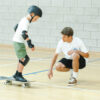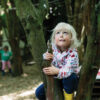
by Justine van de Weg
The Arts College, Worthing
Do you find you become irritated at times when your child will not listen to you? Some days you may feel like ripping your hair out in frustration! When you understand how children think, it can sometimes give you a clearer perspective.
Children are developing their brains, fine motor muscles in their hands, co-ordination, speech and walking on a daily basis. It can be easy to assume that when a child can put a sentence together they know or understand how situations, conversations or emotions work. As an adult, this is second nature. However, think about when you, as an adult, start a job for the first time. Could you fully operate the office, know where all the paper work is, how to answer the phone, who to speak to, where to find materials or resources? Think back to the time you learnt how to drive. You had to learn how the gears, accelerator, steering wheel and rear view mirror work together as a team.
The communication processes that are constantly developing within a child are the sensory senses. Sight, smell, taste, touch and hearing. When children are trying to communicate they will communicate through senses and exploring. Putting it simply – children use less words. When you grow up and become an adult, your senses are second nature and not much thought is given to the development of your senses. As an adult, you rely more on logical thinking, words, actions and, of course, assumptions based on what you have learnt from the adults who surrounded you when you were growing up. Putting it simply – adults use more words.
When adults and children become frustrated with one another, it’s because one is communicating with too many words, and the other (mostly the child) is trying to understand the words, but cannot because they don’t relate to their senses and understanding. Their processing is through senses. When you ask children how they feel, although they can speak, they cannot always say how they feel, or why they feel irritable or angry. This is because they need support and guidance from the adult to communicate through their senses.
Tips to help:
1 Communicate through pictures. Instead of asking children how they feel, ask them to point to a face that has an expression. You can draw various faces ranging from smiling to angry. Number the faces up to 10 so that you know the extent of irritation or anger.
2 Have activities around that can help children release anger – for example: a punching bag, trampoline, swinging tennis ball or a ‘screaming pillow’.
Giving a child an activity with the expectation of them just doing it will not always work. They are still learning and the only way they learn is by watching their parents and the adults surrounding them.
When your child is working through the activity, it is important to ask them if they want you near them or they want you to leave them alone. With some activities they may just want you to stand there whilst they hit the ball, or jump on the trampoline.
3 Sensory activity suggestions include breathing exercises, chopping up strips of hard food like carrots and getting children chewing on them or having relaxing and calming oil smells in the house.
4 EFT – this is an emotional freedom technique. Tapping on certain acupressure points on the body stimulates the effect as if attending an acupuncture session, only without the needles. Great EFT points which I always use with children are the point on the chest, just below the collar bone closest to the shoulder, and the side of the hand .When parents are willing to do this activity with their children, the children will follow their lead.











